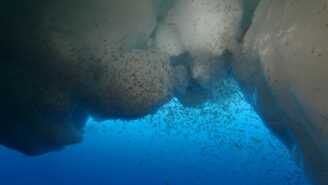Our group aims to get a mechanistic understanding of physiological and genetic principles of essential life cycle functions (e. g. seasonal maturation, growth, lipid dynamic, larval development) of polar pelagic macrozooplankton groups such as krill, the artic calanus-complex, and salps, in order to understand their plasticity to climate driven environmental changes and to identify overarching principles of adaptive mechanisms between these groups.
Organisms in these groups serve as key species due to their strong impact in ecosystem functioning and their population shifts can act as indicator for ecosystem changes.
Our approach is to identify bottlenecks in the life cycle of key species, in relation to environmental factors, which are affected and unaffected by increasing anthropogenic CO2 emission (temperature, sea ice, photoperiod, respectively). We study these species in all their ontogenetic complexity by using a comprehensive setup of sampling devises, experimental process studies, and analytical tools on different spatial – and biodiversity scales.
The generated data will be embedded in individual-based models and ontogenetic-population dynamic models to a) enable predictions on population shifts of polar pelagic key species, b) identify mechanistic relation shifts between annual fluctuations of the abundance of these species in relation to changing environmental factors and c) identify ecosystem responses due to population shifts in terms of biogeochemical cycles. The group provides critical scientific information for krill fishery and the establishment of Marine Protected Areas (MPAs) in the Southern Ocean, both managed by the Commission for the Conservation of Antarctic Marine Living Resource (CCAMLR), by presenting the scientific results to the Commission.
Our research foci contribute to the HIFMB research areas Biodiversity Change and Conservation & Management.
Read more about:
- Ecophysiology of Pelagic Key Species at AWI
- Biodiversity and Biological Processes in Polar Oceans at ICBM
- Polartime
Our team for Ecophysiology of Pelagic Key Species
Bettina Meyer
Ecophysiologist, Head of Ecophysiology of Pelagic Key SpeciesNews and articles on the topic
Krill Faecal Pellets are More Efficiently Exported to Depth Than Salp Pellets
The Southern Ocean is one of the most important oceanic regions for uptake and storage of carbon dioxide (CO2) from the atmosphere. This uptake of CO2 is driven by faecal pellets produced by Antarctic krill (Euphausia superba) and salps (Salpa thompsoni), krill and salp poo, the most important macrozooplankton grazers in the Southern Ocean. Even …

